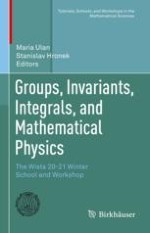This volume presents lectures given at the Wisła 20-21 Winter School and Workshop: Groups, Invariants, Integrals, and Mathematical Physics, organized by the Baltic Institute of Mathematics. The lectures were dedicated to differential invariants – with a focus on Lie groups, pseudogroups, and their orbit spaces – and Poisson structures in algebra and geometry and are included here as lecture notes comprising the first two chapters. Following this, chapters combine theoretical and applied perspectives to explore topics at the intersection of differential geometry, differential equations, and category theory. Specific topics covered include:
The multisymplectic and variational nature of Monge-Ampère equations in dimension fourIntegrability of fifth-order equations admitting a Lie symmetry algebraApplications of the van Kampen theorem for groupoids to computation of homotopy types of striped surfacesA geometric framework to compare classical systems of PDEs in the category of smooth manifolds
Groups, Invariants, Integrals, and Mathematical Physics is ideal for graduate students and researchers working in these areas. A basic understanding of differential geometry and category theory is assumed.
